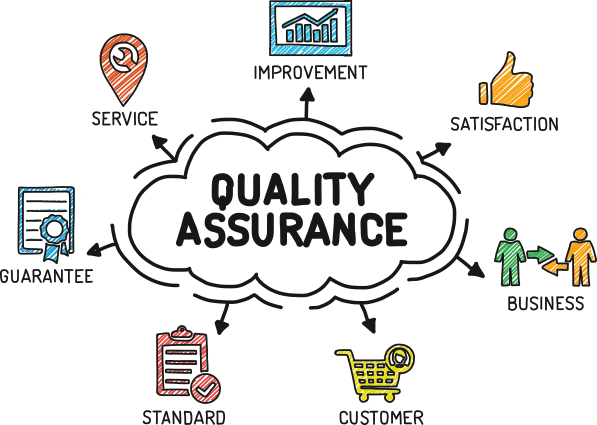Unveiling the Five situations of Assurance Understanding the Hierarchy of Assurance Engagements
Exordium
Assurance engagements are essential processes that give credibility and confidence in the delicacy of information or compliance with specific norms. These engagements are conducted by good professionals who estimate and report on the subject matter's trustability. The situations of assurance vary grounded on the extent of work performed and the position of assurance handed to stakeholders. This comprehensive companion explores the five situations of assurance engagements, ranging from loftiest to smallest, to understand their significance and operation in different surrounds.
1. Level 5 No Assurance
At the smallest position of assurance, Level 5, there's no formal assurance engagement conducted. This means that there's no evaluation or testing of the subject matter's trustability or compliance with norms. No assurance is handed, and stakeholders are left without any independent verification.
Position 5 is generally suitable for situations where no formal assurance is needed, similar as when the information is readily empirical , the pitfalls are minimum, or the cost- benefit analysis doesn't warrant a more expansive assurance engagement. While Level 5 doesn't involve a formal assessment, it's essential for stakeholders to be apprehensive that no independent evaluation has been conducted in these cases.
2. position 4 compendium Engagements
Position 4 assurance engagements involve compendium engagements, where the accountant compiles fiscal information handed by the reality into fiscal statements without conducting an inspection or review. In a compendium engagement, the accountant presents the fiscal information in the form of fiscal statements without furnishing any assurance on the delicacy or absoluteness of the data.
In a compendium engagement, the accountant's part is limited to presenting the information in a structured format. They don't estimate the information's trustability or perform any substantial testing. thus, stakeholders must be conservative when counting on the fiscal statements from a compendium engagement, as no assurance is handed on the delicacy or fairness of the information.
3. Position 3 Review Engagements
Position 3 assurance engagements are review engagements, where the adjudicator provides limited assurance on the fiscal information or subject matter. In a review engagement, the adjudicator performs logical procedures and inquiries to gain a moderate position of assurance that there are no material misstatements in the fiscal information.
During a review engagement, the adjudicator's procedures are more limited compared to an inspection, and the compass of work isn't as comprehensive. still, the review process still provides stakeholders with a degree of comfort regarding the trustability of the information. The adjudicator expresses limited assurance by stating that nothing has come to their attention that would indicate significant misstatements in the fiscal statements.
Review engagements are generally chosen when stakeholders bear some position of assurance but don't bear the comprehensive examination handed by an inspection. This position of assurance strikes a balance between cost- effectiveness and the need for a reasonable position of confidence in the fiscal information.
4. Position 2 Agreed- Upon Procedures( AUP) Engagements
Position 2 assurance engagements are Agreed- Upon Procedures( AUP) engagements, where the adjudicator performs specific procedures agreed upon by the engaging parties. In AUP engagements, the adjudicator doesn't give an overall conclusion or opinion on the subject matter's trustability. rather, they present factual findings grounded on the agreed- upon procedures.
The procedures performed in AUP engagements can vary extensively and are acclimatized to the specific requirements of the engaging parties. These procedures may include testing specific deals, examining specific accounts, or vindicating compliance with specific regulations or contractual conditions. The AUP report provides a detailed account of the adjudicator's findings, leaving stakeholders to draw their conclusions grounded on the factual information presented.
AUP engagements are particularly useful when stakeholders have specific enterprises or bear assurance on particular aspects of the subject matter. This position of assurance is flexible and can be acclimated to address colorful issues without the need for a comprehensive examination.
5. position 1 inspection Engagements
At the loftiest position of assurance, Level 1, we've inspection Engagements. inspection engagements involve the most expansive and rigorous position of examination of the subject matter's trustability or compliance. In an inspection engagement, the adjudicator conducts comprehensive testing, examination, and verification of the subject matter to give a high position of assurance.
During an inspection engagement, the adjudicator evaluates internal controls, performs substantial testing, and verifies the delicacy and absoluteness of the information. The inspection process aims to give reasonable assurance that the subject matter is free from material misstatement or that the reality is in compliance with applicable norms, regulations, or contractual conditions.
inspection engagements are generally used for fiscal statement checkups, where adjudicators assess the fairness and delicacy of an reality's fiscal statements. The inspection report includes the adjudicator's opinion on the fairness of the fiscal statements and provides stakeholders with a high position of confidence in the trust ability of the information.
Conclusion
Assurance engagements are pivotal for furnishing stakeholders with confidence in the trust ability of information and compliance with specific norms. The five situations of assurance offer a scale of approaches, each suited to different requirements and situations of confidence needed by stakeholders. Level 5, with no assurance, is applicable for situations where no formal evaluation is necessary. position 4, compendium engagements, involves presenting fiscal information without assurance. Level 3, review engagements, provides limited assurance through logical procedures and inquiries. position 2, agreed- upon procedures engagements, knitters specific procedures to stakeholders' requirements, and presents factual findings. Eventually, Level 1, inspection engagements, offers the loftiest position of assurance through comprehensive testing and verification.
By understanding the distinctions between these situations of assurance, stakeholders can elect the applicable position of engagement that aligns with their requirements for credibility and confidence in the subject matter under consideration. Professional adjudicators and accountants play a vital part in conducting these engagements, helping to insure translucency, trust ability, and trust in fiscal information and compliance matters.

